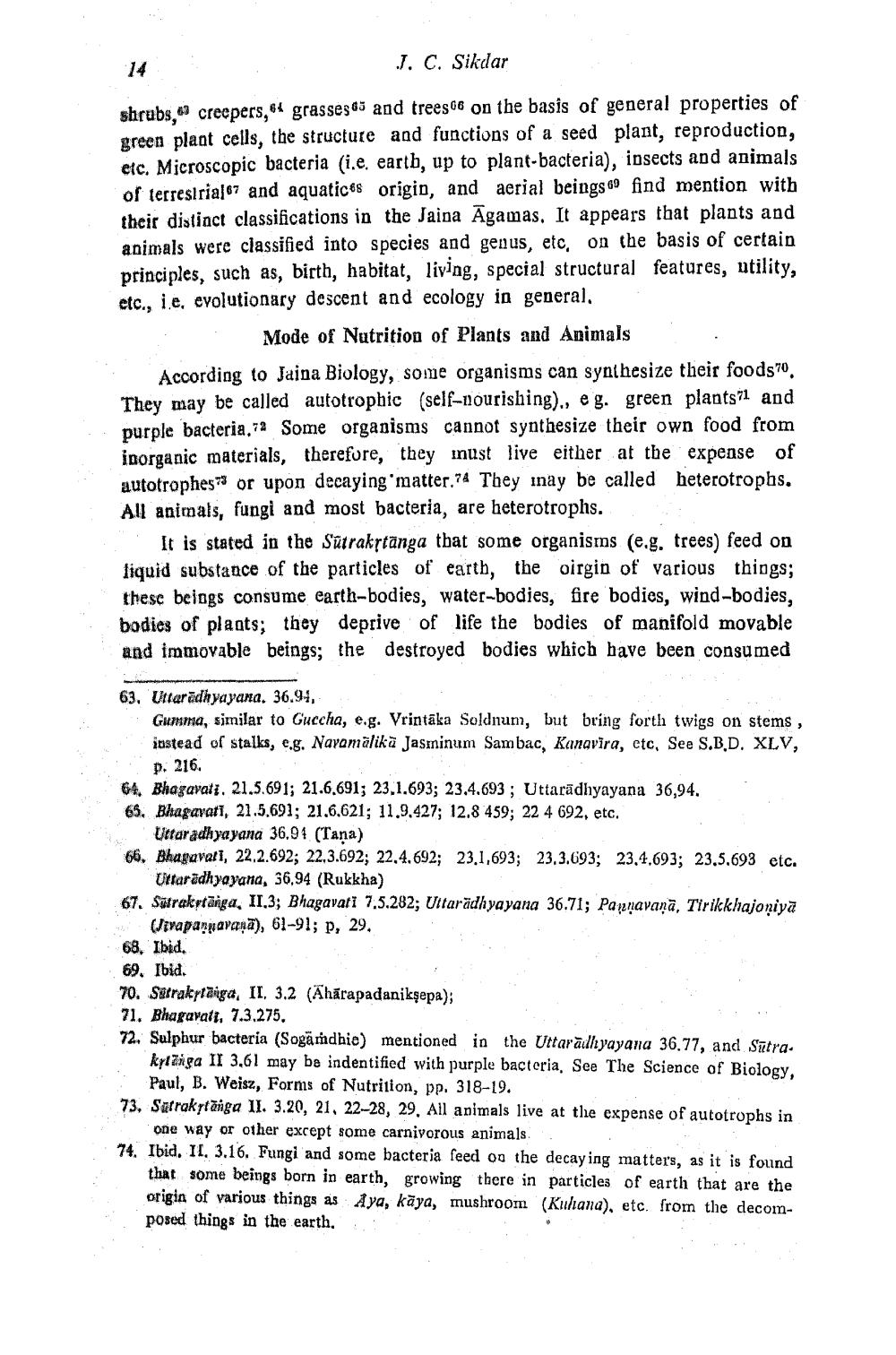________________
J. C. Sikdar
shrubs, creepers, grasses 65 and trees 66 on the basis of general properties of green plant cells, the structure and functions of a seed plant, reproduction, etc. Microscopic bacteria (i.e. earth, up to plant-bacteria), insects and animals of terrestria[67 and aquatices origin, and aerial beings 69 find mention with their distinct classifications in the Jaina Agamas. It appears that plants and animals were classified into species and genus, etc, on the basis of certain principles, such as, birth, habitat, living, special structural features, utility, etc.. ie, evolutionary descent and ecology in general,
Mode of Nutrition of Plants and Animals According to Jaina Biology, some organisms can synthesize their foods7o. They may be called autotrophic (self-nourishing)., eg. green plantsol. and purple bacteria.va Some organisms cannot synthesize their own food from inorganic materials, therefore, they must live either at the expense of autotrophes or upon decaying matter.74 They inay be called heterotrophs. All animals, fungi and most bacteria, are heterotrophs
It is stated in the Sütrakrtänga that some organisms (e.g. trees) feed on liquid substance of the particles of earth, the oirgin of various things; these beings consume earth-bodies, water-bodies, fire bodies, wind-bodies, bodies of plants; they deprive of life the bodies of manifold movable and immovable beings; the destroyed bodies which have been consumed
63. Uttaradhyayana. 36.94,
Gumma, similar to Guccha, e.g. Vrintāka Soldnum, but bring forth twigs on stems, instead of stalks, eg. Navamälika Jasminum Sambac, Kanavira, etc. See S.B.D. XLV,
p. 216. 64. Bhagavati. 21.5.691; 21.6.691; 23.1.693; 23.4.693; Uttaradhyayana 36,94. 65. Bhagavati, 21.5.691; 21.6.621; 11.9.427; 12.8 459; 22 4 692, etc.
Uttaradhyayana 36,91 (Tana) 66. Bhagavati, 22.2.692; 22.3.692; 22.4.692; 23.1,693; 23.3.693; 23.4.693; 23.5.693 etc.
Uttaradhyayana, 36,94 (Rukkha) 67. Sätrakytānga, II.3; Bhagavati 7.5.282; Uttarëdhyayana 36.71; Pannavaņā, Tirikkhajoniya
Nirapannavanā), 61-91; p, 29. 68. Ibid. 69. Ibid. 70. Setraktaiga, II, 3.2 (Ähārapadanikṣepa); 71. Bhagavati, 7.3.275. 72. Sulphur bacteria (Sogamdhie) mentioned in the Uttarādhyayana 36.77, and Satra.
kytänga II 3.61 may be indentified with purple bacteria. See The Science of Biology,
Paul, B. Weisz, Forms of Nutrition, pp. 318-19. 73. Sarrakytănga II. 3.20, 21, 22-28, 29. All animals live at the expense of autotrophs in
one way or other except some carnivorous animals 74. Ibid. II, 3.16. Fungi and some bacteria feed on the decaying matters, as it is found
that some beings born in earth, growing there in particles of earth that are the origin of various things as Aya, kāya, mushroom (Kulana), etc. from the decomposed things in the earth.
S




